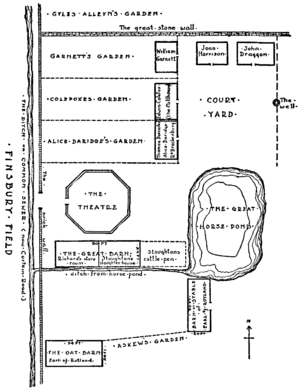James Burbage facts for kids
Quick facts for kids
James Burbage
|
|
|---|---|
| Born | c. 1531 |
| Died | 1597 (aged about 66) |
| Occupation |
|
| Known for | Building The Theatre |
| Spouse(s) | Ellen Burbage (nee Brayne) |
| Children | |
James Burbage (born around 1531 – died 2 February 1597) was an important English actor and theatre builder. He was also a joiner, which is someone who builds things with wood. James Burbage is famous for building The Theatre. This was the first permanent theatre built in England since the time of the ancient Romans.
Contents
James Burbage's Life Story
James Burbage was born around 1531. He probably grew up in Bromley in Kent, England. When he was young, he learned the trade of a joiner in London. This meant he became skilled at working with wood. In 1559, records show he was a qualified joiner. His carpentry skills later helped him a lot when he started managing theatres.
Starting a Career in Theatre
James Burbage became an actor. By 1572, he was the leader of a theatre group called Leicester's Men. He had many talents, including acting, building, and owning theatres. People said he was a key person who helped theatre grow in England. He helped connect the older medieval plays with the amazing plays of the Elizabethan Theatre era.
Someone who knew James Burbage described him as handsome and charming. They also said he was honest and witty. He was the father of Richard Burbage, who became a very famous actor. Richard Burbage was also a personal friend of William Shakespeare.
James Burbage's Family
On April 23, 1559, James Burbage married Ellen Brayne. Her father was a tailor in London. Ellen's brother, John Brayne, later became James's business partner. By 1576, James and Ellen lived in Shoreditch, a part of London.
Their older son, Cuthbert Burbage, followed his father. He also became a theatre manager. Their younger son, Richard Burbage, became one of the best actors of his time. Richard worked closely with Shakespeare. They were even co-owners of the famous Globe Theatre.
His Final Years
James Burbage passed away on February 2, 1597. He was buried in Shoreditch, near St. Leonard's church. Many other actors from that time are also buried there. James died without leaving a will. Before he passed, he had given his Blackfriars property to his son Richard. He gave his personal items to his grandson Cuthbert.
James died just before the lease on The Theatre was going to run out. After his death, his son Richard built a new theatre. This new theatre was across the River Thames. It became known as the Globe Theatre.
Building The Theatre
In 1576, James Burbage and his partner John Brayne decided to build a new, permanent stage. This was a big deal because it was one of the first permanent theatres in London since Roman times.
John Brayne was James's brother-in-law and had a lot of money. His investment helped pay for The Theatre. James also took out a loan on the land lease. They planned to share the money they made equally. They even started putting on plays before the building was finished. The money from these early shows helped them pay to complete the theatre.
James Burbage was the only one who signed the lease for The Theatre's land. This happened on April 13, 1576. Because he owned the lease, he also collected rent from other buildings on the site. He paid about £14 a year for the land. We don't know for sure who built The Theatre. But it might have been James Burbage's brother, Robert, who was a carpenter.
In 1594, a special order was made. It created a theatre company called the Lord Chamberlain's Men. This group, which Shakespeare belonged to, was given the only right to perform in London at The Theatre.
Performances at The Theatre
James Burbage was sure that people would come to The Theatre. Even if they had to walk through open fields to get there, he believed they would come. One person from that time said crowds of people would stream out of the city to watch plays there.
The Theatre was mostly made of wood. It had a special area for the actors to get ready, called a tiring house. There were also galleries and special seats. These seats offered better views and more privacy. They usually cost an extra penny or two pence. Regular tickets cost one penny.
Another theatre, the Curtain Theatre, was built nearby. It was only about 200 yards closer to the city. Henry Lanman built it. He worked closely with James Burbage. The two theatres sometimes shared their profits. The Curtain Theatre helped introduce people to the more complex plays at The Theatre. Over time, plays became more organized and popular. More playhouses like The Rose and The Swan were built.
The Blackfriars Theatre
On February 4, 1596, James Burbage bought a property called the Blackfriars Theatre. He paid £600 for it. This building used to be a Dominican monastery. James wanted to turn it into the first permanent indoor theatre in England. However, in November 1596, people living in the area complained. They managed to get a ban on play performances at the theatre.


